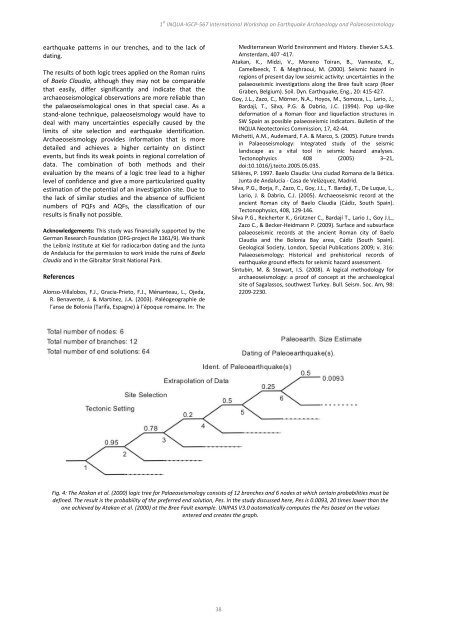Archaeoseismology and Palaeoseismology in the Alpine ... - Tierra
Archaeoseismology and Palaeoseismology in the Alpine ... - Tierra
Archaeoseismology and Palaeoseismology in the Alpine ... - Tierra
Create successful ePaper yourself
Turn your PDF publications into a flip-book with our unique Google optimized e-Paper software.
earthquake patterns <strong>in</strong> our trenches, <strong>and</strong> to <strong>the</strong> lack of<br />
dat<strong>in</strong>g.<br />
The results of both logic trees applied on <strong>the</strong> Roman ru<strong>in</strong>s<br />
of Baelo Claudia, although <strong>the</strong>y may not be comparable<br />
that easily, differ significantly <strong>and</strong> <strong>in</strong>dicate that <strong>the</strong><br />
archaeoseismological observations are more reliable than<br />
<strong>the</strong> palaeoseismological ones <strong>in</strong> that special case. As a<br />
st<strong>and</strong>‐alone technique, palaeoseismology would have to<br />
deal with many uncerta<strong>in</strong>ties especially caused by <strong>the</strong><br />
limits of site selection <strong>and</strong> earthquake identification.<br />
<strong>Archaeoseismology</strong> provides <strong>in</strong>formation that is more<br />
detailed <strong>and</strong> achieves a higher certa<strong>in</strong>ty on dist<strong>in</strong>ct<br />
events, but f<strong>in</strong>ds its weak po<strong>in</strong>ts <strong>in</strong> regional correlation of<br />
data. The comb<strong>in</strong>ation of both methods <strong>and</strong> <strong>the</strong>ir<br />
evaluation by <strong>the</strong> means of a logic tree lead to a higher<br />
level of confidence <strong>and</strong> give a more particularized quality<br />
estimation of <strong>the</strong> potential of an <strong>in</strong>vestigation site. Due to<br />
<strong>the</strong> lack of similar studies <strong>and</strong> <strong>the</strong> absence of sufficient<br />
numbers of PQFs <strong>and</strong> AQFs, <strong>the</strong> classification of our<br />
results is f<strong>in</strong>ally not possible.<br />
Acknowledgements: This study was f<strong>in</strong>ancially supported by <strong>the</strong><br />
German Research Foundation (DFG‐project Re 1361/9). We thank<br />
<strong>the</strong> Leibniz Institute at Kiel for radiocarbon dat<strong>in</strong>g <strong>and</strong> <strong>the</strong> Junta<br />
de Andalucía for <strong>the</strong> permission to work <strong>in</strong>side <strong>the</strong> ru<strong>in</strong>s of Baelo<br />
Claudia <strong>and</strong> <strong>in</strong> <strong>the</strong> Gibraltar Strait National Park.<br />
References<br />
Alonso‐Villalobos, F.J., Gracia‐Prieto, F.J., Ménanteau, L., Ojeda,<br />
R. Benavente, J. & Martínez, J.A. (2003). Paléogeographie de<br />
l’anse de Bolonia (Tarifa, Espagne) à l’époque roma<strong>in</strong>e. In: The<br />
1 st INQUA‐IGCP‐567 International Workshop on Earthquake Archaeology <strong>and</strong> <strong>Palaeoseismology</strong><br />
38<br />
Mediterranean World Environment <strong>and</strong> History. Elsevier S.A.S.<br />
Amsterdam, 407 ‐417.<br />
Atakan, K., Midzi, V., Moreno Toiran, B., Vanneste, K.,<br />
Camelbeeck, T. & Meghraoui, M. (2000). Seismic hazard <strong>in</strong><br />
regions of present day low seismic activity: uncerta<strong>in</strong>ties <strong>in</strong> <strong>the</strong><br />
palaeoseismic <strong>in</strong>vestigations along <strong>the</strong> Bree fault scarp (Roer<br />
Graben, Belgium). Soil. Dyn. Earthquake, Eng., 20: 415‐427.<br />
Goy, J.L., Zazo, C., Mörner, N.A., Hoyos, M., Somoza, L., Lario, J.,<br />
Bardají, T., Silva, P.G. & Dabrio, J.C. (1994). Pop up‐like<br />
deformation of a Roman floor <strong>and</strong> liquefaction structures <strong>in</strong><br />
SW Spa<strong>in</strong> as possible palaeoseismic <strong>in</strong>dicators. Bullet<strong>in</strong> of <strong>the</strong><br />
INQUA Neotectonics Commission, 17, 42‐44.<br />
Michetti, A.M., Audemard, F.A. & Marco, S. (2005). Future trends<br />
<strong>in</strong> <strong>Palaeoseismology</strong>: Integrated study of <strong>the</strong> seismic<br />
l<strong>and</strong>scape as a vital tool <strong>in</strong> seismic hazard analyses.<br />
Tectonophysics 408 (2005) 3–21,<br />
doi:10.1016/j.tecto.2005.05.035.<br />
Sillières, P. 1997. Baelo Claudia: Una ciudad Romana de la Bética.<br />
Junta de Andalucía ‐ Casa de Velázquez, Madrid.<br />
Silva, P.G., Borja, F., Zazo, C., Goy, J.L., T. Bardají, T., De Luque, L.,<br />
Lario, J. & Dabrio, C.J. (2005). Archaeoseismic record at <strong>the</strong><br />
ancient Roman city of Baelo Claudia (Cádiz, South Spa<strong>in</strong>).<br />
Tectonophysics, 408, 129‐146.<br />
Silva P.G., Reicherter K., Grützner C., Bardají T., Lario J., Goy J.L.,<br />
Zazo C., & Becker‐Heidmann P. (2009). Surface <strong>and</strong> subsurface<br />
palaeoseismic records at <strong>the</strong> ancient Roman city of Baelo<br />
Claudia <strong>and</strong> <strong>the</strong> Bolonia Bay area, Cádiz (South Spa<strong>in</strong>).<br />
Geological Society, London, Special Publications 2009; v. 316:<br />
<strong>Palaeoseismology</strong>: Historical <strong>and</strong> prehistorical records of<br />
earthquake ground effects for seismic hazard assessment.<br />
S<strong>in</strong>tub<strong>in</strong>, M. & Stewart, I.S. (2008). A logical methodology for<br />
archaeoseismology: a proof of concept at <strong>the</strong> archaeological<br />
site of Sagalassos, southwest Turkey. Bull. Seism. Soc. Am, 98:<br />
2209‐2230.<br />
Fig. 4: The Atakan et al. (2000) logic tree for <strong>Palaeoseismology</strong> consists of 12 branches <strong>and</strong> 6 nodes at which certa<strong>in</strong> probabilities must be<br />
def<strong>in</strong>ed. The result is <strong>the</strong> probability of <strong>the</strong> preferred end solution, Pes. In <strong>the</strong> study discussed here, Pes is 0.0093, 20 times lower than <strong>the</strong><br />
one achieved by Atakan et al. (2000) at <strong>the</strong> Bree Fault example. UNIPAS V3.0 automatically computes <strong>the</strong> Pes based on <strong>the</strong> values<br />
entered <strong>and</strong> creates <strong>the</strong> graph.



